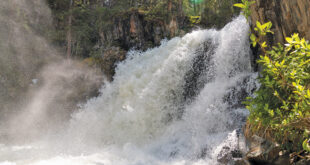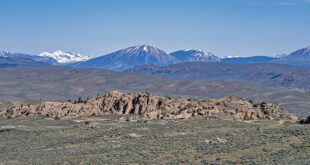Tri-State, the utility that generates electricity for 44 rural electric cooperatives including Gunnison County Electric Association (GCEA), continues to push for an 895 megawatt coal-fired plant in Holcomb, Kansas. Despite overwhelming evidence produced by Tri-State itself that it does not need additional coal-fired generation capacity, Tri-State still supports the Holcomb 2 unit as an “option” for the future.
Tri State has already spent more than $70 million to preserve the option of developing a facility that was denied in 2007 because of unacceptable impacts on human health and the environment. Many residents of the Gunnison Valley are GCEA members and are unknowingly contributing to this large investment in unneeded, risky and dirty power that would only add to our energy provider’s over-reliance on coal and vulnerability to future fuel and emissions price increases. Alarmingly, the $70 million doesn’t even begin to cover the costs of building the plant, an expense GCEA members would also contribute to if construction moves forward.
The likelihood of a green light to begin construction at Holcomb is increasing: in December 2010, the Kansas Department of Health and Environment (KDHE) issued an air quality permit for Holcomb 2. A high-profile and extremely controversial debate has surrounded the Holcomb coal plant expansion for five years. While the plant would be built in Kansas by Sunflower Electric, most of the power would go to Tri-State’s customers.
In 2010, Tri-State undertook a comprehensive resource planning process that was a significant step in terms of taking public input and considering alternative energy sources. The permitting of Holcomb 2 exposes inconsistencies between Tri-State’s actual energy needs and their continued pursuit of the plant. Tri-State’s 20-year Electric Resource Plan (ERP) projects that “it will not need additional resources to satisfy its system capacity requirements until at least 2019” and that capacity will be met with a combination of renewables, gas and efficiency programs.
In fact, in all but one of the 24 scenarios that Tri-State analyzed during the resource planning process, its own models showed zero need for any new coal-burning generation capacity through 2029. And even in the one scenario that did, which was based on highly unrealistic assumptions, only 300 MW of new coal-burning capacity would be needed, and not until 2027.
As a cooperative utility, Tri-State readily acknowledges that it “has no incentive to … build resources beyond those reasonably needed by its members over time.” Sunflower, the chief project proponent, says explicitly that it expects Tri-State to own 695 MW of the plant’s 895 MW capacity. This exposes GCEA ratepayers to financial risk: under Kansas state law, construction on the Holcomb plant has to begin within 18 months of the permit being issued, even though Tri-State doesn’t see a need for any new power before 2019. Tri-State’s share of the $2.2 billion plant could leave its customers responsible for covering a majority of those costs, for electricity that isn’t even needed. As one of Tri-State’s 44 members, GCEA’s share of this cost would be significant and would ultimately be passed on to its end-use consumers, residents of the Gunnison Valley.
On top of serious economic and environmental concerns, suspicious political maneuvering took place to permit Holcomb 2. Under political pressure and despite public opposition, KDHE rushed to issue the permit prior to January 2, when new EPA greenhouse gas regulations would have been applicable. Former KDHE secretary Rod Bremby, who denied the first permit for the Holcomb expansion, was suspiciously and abruptly removed from KDHE during the permit application process and has since stated that “If you look at the influence of lobbying dollars in this process, it is staggering.” In discussing the “abuses” that took place to permit Holcomb 2, Bremby said, “If we are to protect this exercise, this way of governing ourselves, things like this can’t happen.” So now, Sunflower and Tri-State may have a new coal plant that’s not built yet and will not be subject to new EPA rules that provide necessary public protections.
Proponents of the project have talked about “clean coal” and Holcomb 2 being the “cleanest coal plant in the country.” These claims are false, according to a report compiled by MSB Energy Associates and the Natural Resources Defense Council. Compared against the approved Holcomb 2 permit, there are already at least 669 coal plants emitting lower rates of particulates, 321 coal plants emitting lower rates of Mercury, 53 coal plants emitting lower rates of sulfur dioxide and 18 coal plants emitting lower rates of nitrogen oxides. Additionally, the KDHE permit for Holcomb 2 requires no emissions controls for carbon dioxide or other greenhouse gas emissions.
High Country Citizens’ Alliance fears that GCEA and their member-owners could stand to lose financially if Tri-State ends up owning 695 MW of unneeded output from Holcomb 2. In the face of an urgent need to reduce greenhouse gas emissions and the unnecessary financial risks of owning unneeded coal power, our Climate and Clean Energy Program is working to urge Tri-State to abandon pursuit of this risky coal plant. Instead, the many benefits to its customers and communities it serves—from cost-saving efficiency programs to local renewable energy development—that are built into the 2010 Resource Plan should be the main guide for Tri-State’s future. Your elected GCEA board of directors serves the cooperative to represent your interests.
To find your director and their contact information visit http://www.gcea.coop/About/directors.cfm. Then, let your elected GCEA director know that Holcomb 2 is a financial and environmental risk that we are better off without.
-By Chris Menges, Climate and Clean Energy Director,
High Country Citizens’ Alliance
chris@hccaonline.org
 The Crested Butte News Serving the Gunnison Valley since 1999
The Crested Butte News Serving the Gunnison Valley since 1999





